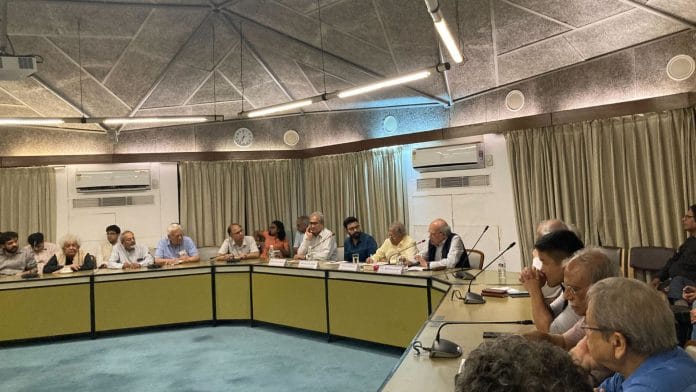New Delhi: Coalition governments do not necessarily lead to a frequent change of guard at the finance ministry. Nor do these turnovers put a question mark on the efficacy of policy making, claimed author AK Bhattacharya during the launch of his latest book India’s Finance Ministers: Stumbling into Reforms (1977 – 1998).
“One of the most stable governments at the time – the Rajiv Gandhi administration – with 435 seats in the Parliament of India saw four finance ministers. It should not be taken for granted that if you have a coalition government, you would see more number of finance ministers,” said Bhattacharya, the editorial director of Business Standard, at an event recently held at New Delhi’s India International Centre. It saw the attendance of former Indian finance minister P Chidambaram as well as several retired bureaucrats with linkages to the finance ministry.
Prime Minister Narendra Modi has often mocked the possibility of a coalition government spearheaded by INDIA. They would be busy with “swearing-in events”, he said recently, “changing their prime ministers every year” as the nation dealt “with difficult events”.
“The country has seen instability for 30 years,” Modi claimed during an interview with another Indian media outlet, implying that a coalition government could only bring confusion in its wake.
Bhattacharya’s understanding of the situation, however, added a certain nuance to the conversation. He pointed out that even majority governments can show signs of constant cabinet minister shuffling.
The first 30 years after India’s Independence (1947–1977) saw 10 finance ministers. Bhattacharya’s second book in the India’s Finance Ministers series covers 12 finance ministers between the 21-year period of 1977 and 1998.
The other two panellists – Rakesh Mohan, the former Chief Economic Advisor to the government and Brijeshwar Singh, a retired bureaucrat – then began to share their unusual experiences at the country’s finance ministry.
Also read: Nehru’s foibles & failures. Scholars didn’t just laud former PM at his commemoration
Unending mysteries of the Planning Commission
The mysteries of the Planning Commission of India and its relationship with the finance ministry seem to have bewildered even the former bureaucrats. None of the discussants were able to arrive at a consensus on how the Commission operated.
Did the Planning Commission – dissolved by Modi in 2014 and replaced with the NITI Aayog – have the power to set borrowing limits for state governments, or did it have the right to disburse funds for development? The retired government officers were themselves unable to offer a clear picture.
The discussion eventually veered from the history of India’s finance ministers to the operation of the Commission. This came after an audience member questioned the relationship between the North Block and Yojana Bhawan.
“There was always a tussle between the Planning Commission and the Finance Ministry, as the Commission always wanted more money for their plans, especially during the crafting of the [Union] Budget,” Mohan replied.
As per Singh, the Planning Commission was able to sell its utility to repeated governments by promising “more votes” if more funds were allocated toward the various five-year plans thought up by them.
“The Planning Commission did try to elbow itself into issues that were the Finance Ministry’s turf. The Commission started setting a ceiling on how much state governments could borrow,” explained Singh, adding that this was the “only time” he believed that the Commission had “overstepped its bounds.”
Mohan, however, disagreed. He asserted that the Commission did not have the power to set policy limits for state governments. Nevertheless, the discussion left the audience still pondering how the two government bodies interacted with one another.
“The big battles between the two were always based on the size of the plan and the budget support for it. That did sometimes involve the Prime Minister of the time as well,” said Mohan.
Singh pointed out that the Commission allowed chief ministers backdoor access to the PM. CMs would often turn up at the Yojana Bhawan, where they would meet with the deputy planning commissioner (who answered directly to the PM). Today, Yojana Bhawan has been rechristened as NITI Bhawan, along with the organisation.
An audience member stepped in to describe the Commission with words commonly attributed to Rajiv Gandhi: “The Planning Commission are a bunch of jokers.”
(Edited by Zoya Bhatti)






